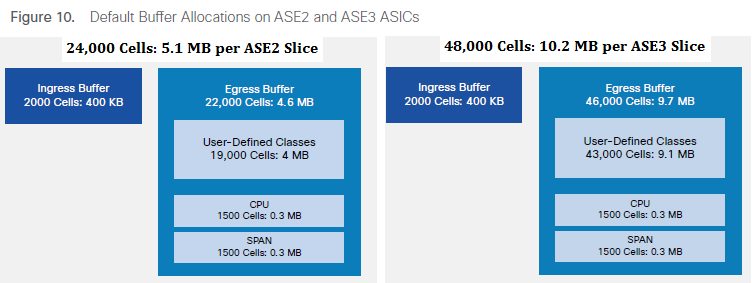| Model | ASIC | Throughput | 1 GE | 10 GE | 25 GE | 40 GE | 100 GE | Slice Buffer |
| 92160YC-X | ASE3 | 3.2 Tb/s | 64 | 56 | 56 | 6 | 4 | 10 MB |
| 9272Q | ASE2 | 5.76 Tb/s | - | 140 | - | 72 | - | 5 MB |
| 92304QC | ASE2 | 6.08 Tb/s | - | 64 | - | 64 | 8 | 5 MB |
| 9236C | ASE2 | 7.2 Tb/s | - | 144 | 144 | 36 | 36 | 5 MB |
| 92300YC | ASE2 | 6.0 Tb/s | - | 48 | 48 | 18 | 18 | 5 MB |
ASE = Application Spine Engine
Cisco did a raft of announcements that included 9200s. Previous version used a trident-2 along with Cisco custom ALE-2 ASIC that fixed warts in the trident-2. The new 92xx switches are full custom: ASE-2 and ASE-3. Date of first publication of the hardware installation guide is Feb 8, 2016. Since this web page is primarily about buffering:

This was copied out of architecture paper. The newer 9200 claims to have less memory than the older 9300. That is because the 9300 was a warts-on-a-pig product.
Note that the ASICs are built in slices with memory belonging to each slice. This is perhaps the first silicon designed to address Elephant versus Mice flows. The ASE claims to find the elephants on the fly and decrease their priority to keep the world safe for mice. Sadly, the architecture paper does not disclose the number of elephants and mice that can be active in the ASE ASIC at one time.
This is good for the data center, and probably not good for big science in the wide area. In a world of 100 uS RTT, elephants can rapidly climb to fill all buffers. This starves the mice. But it is not clear this happens in WAN networking.
The Nexus 9200 shares the same bug as the first generation of Broadcom Tomahawk ASICs. In both cases, the ASIC design was committed before the 25 Gb/s specification was written. In both cases, this means that while 25 Gb/s ports can be used for direct attach copper cables, they cannot be used with optic modules. Neither Cisco nor Broadcom explain this, but the difference between the Nexus 9300 which does not have the problem and the 9200 is clear from the 25 Gb/s compatibility matrix.